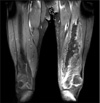Abstract
Diabetic muscle infarction is a rare complication of diabetes mellitus that is not clearly defined in the orthopedic literature. In addition, acute compartment syndrome in association with diabetic muscle infarction is a rarer disease, which has had only a few cases have been reported up to date. A large and painful swelling was noticed in the thigh of a 55-year-old female, who had not experienced trauma. The patient was diagnosed as having compartment syndrome with diabetic muscle infarction by magnetic resonance imaging. The patient underwent immediate fasciotomy, and recovered without any complications.
Figures and Tables
 | Figure 1Diabetic muscle infarction. Shown on axial magnetic resonance imaging. (A) T1 weighted image (repetition time/echo time [TR/TE] 630/13), (B) fat-suppressed T2 weighted image (TR/TE 3100/54), (C) fat-suppressed post-gadolinium T1 weighted image (TR/TE 846/13) shows edema-like signal changes most severely within the vastus medialis muscle and vastus intermedius muscle. Characteristic non-enhancing area of slightly increased T1 and low T2 signal intensity is seen within the vastus medialis and vastus intermedius, with peripheral enhancing edema-like signal. |
 | Figure 2Diabetic muscle infarction. Coronal fat suppressed T1 (repetition time/echo time 661/12) post-intravenous gadolinium image show the longitudinal extent of enhancing signal changes, as well as the longitudinally oriented area of non-enhancement within the vastus medialis containing irregular streaky lines of enhancement. |
References
1. Schwartz JT Jr, Brumback RJ, Lakatos R, Poka A, Bathon GH, Burgess AR. Acute compartment syndrome of the thigh. A spectrum of injury. J Bone Joint Surg Am. 1989. 71:392–400.

2. Umpierrez GE, Stiles RG, Kleinbart J, Krendel DA, Watts NB. Diabetic muscle infarction. Am J Med. 1996. 101:245–250.

3. Smith AL, Laing PW. Spontaneous tibial compartment syndrome in Type 1 diabetes mellitus. Diabet Med. 1999. 16:168–169.

4. Dietrich D, Paley KJ, Ebraheim NA. Spontaneous tibial compartment syndrome: case report. J Trauma. 1994. 37:138–139.
5. Whitesides TE, Haney TC, Morimoto K, Harada H. Tissue pressure measurements as a determinant for the need of fasciotomy. Clin Orthop Relat Res. 1975. (113):43–51.

6. Boody AR, Wongworawat MD. Accuracy in the measurement of compartment pressures: a comparison of three commonly used devices. J Bone Joint Surg Am. 2005. 87:2415–2422.

7. Damron TA, Levinsohn EM, McQuail TM, Cohen H, Stadnick M, Rooney M. Idiopathic necrosis of skeletal muscle in patients who have diabetes. Report of four cases and review of the literature. J Bone Joint Surg Am. 1998. 80:262–267.
8. Miller JW, Fleckenstein J, Nodera H, Herrmann DN. MRI in diabetic muscle infarction. Neurology. 2003. 60:1019.

9. Kapur S, McKendry RJ. Treatment and outcomes of diabetic muscle infarction. J Clin Rheumatol. 2005. 11:8–12.

10. Pamoukian VN, Rubino F, Iraci JC. Review and case report of idiopathic lower extremity compartment syndrome and its treatment in diabetic patients. Diabetes Metab. 2000. 26:489–492.




 PDF
PDF ePub
ePub Citation
Citation Print
Print


 XML Download
XML Download